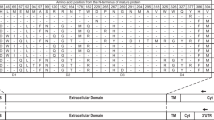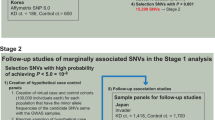Abstract
This study aimed to analyse the association of HLA-B alleles other than -B51 with Behçet’s disease (BD). We also investigated the frequency of HLA-B alleles sharing the same natural killer cell immunoglobulin-like receptor (KIR) binding sequence with HLA-B51. Broad-genotyping of HLA-B locus by PCR-SSOP in 174 Turkish BD patients and 191 healthy controls confirmed the strong association of B*51 with BD (60.9% in BD patients, 24.6% in healthy controls, OR = 4.78). No other HLA-B allele was identified showing an association with BD after adjusting for multiple testing or by using relative predispositional effects (RPE) analysis after the deletion of B*51. HLA-B alleles reacting with the sequence specific oligonucleotide probe 23, which corresponds to the KIR binding site of B*51, were found to be positive in 127 BD patients (73%) and 90 controls (47%) (OR = 3.03, 95% CI 2–4.7). The repeated RPE analysis after separating HLA-B alleles carrying B51-KIR binding sequence as distinct alleles within a broad-type allele group revealed B*2702 allele as the only allele showing an association with BD after the deletion of B*51. Selective increase of B*2702, the only B*27 allele carrying the same KIR binding sequence with B*51, warrants investigation of the possibility of interaction of HLA molecules with KIRs on NK or other T cells in the pathogenesis of BD.
This is a preview of subscription content, access via your institution
Access options
Subscribe to this journal
Receive 6 digital issues and online access to articles
$119.00 per year
only $19.83 per issue
Buy this article
- Purchase on Springer Link
- Instant access to full article PDF
Prices may be subject to local taxes which are calculated during checkout
Similar content being viewed by others
References
Sakane T, Takeno M, Suzuki N, Inaba G . Behçet’s disease N Engl J Med 1999 341: 1284–1291
Gül A . Behçet’s disease: an update on the pathogenesis Clin Exp Rheum 2001 19(Suppl 24): S6–S12
Ohno S, Ohguchi M, Hirose S, Matsuda H, Wakisaka A, Aizawa M . Close association of HLA-Bw51 with Behçet’s disease Arch Ophthalmol 1982 100: 1445–1458
Mizuki N, Ohno S, Tanaka H et al. Association of HLA-B51 and lack of association of class II alleles with Behçet’s disease Tissue Antigens 1992 40: 22–30
Müftüoglu AU, Yazici H, Yurdakul S et al. Behçet’s disease: lack of correlation of clinical manifestations with HLA antigens Tissue Antigens 1981 17: 226–230
Chajek-Shaul T, Pisanty S, Knobler H et al. HLA-B51 may serve as an immunogenetic marker for a subgroup of patients with Behçet’s syndrome Am J Med 1987 83: 666–672
Balboni A, Pivetti-Pezzi P, Orlando P et al. Serological and molecular HLA typing in Italian Behçet’s patients: significant association to B51-DR5-DQw3 haplotype Tissue Antigens 1992 39: 141–143
Lehner T, Batchelor JR, Challacombe SJ, Kennedy L . An immunogenetic basis for the tissue involvement in Behçet’s syndrome Immunology 1979 37: 895–900
Kilmartin DJ, Finch A, Acheson RW . Primary association of HLA-B51 with Behcet’s disease in Ireland Br J Ophthalmol 1997 81: 649–653
Mizuki N, Ohno S, Sato T et al. Microsatellite polymorphism between the tumor necrosis factor and HLA-B genes in Behçet’s disease Hum Immunol 1995 43: 129–135
Mizuki N, Ota M, Kimura M et al. Triplet repeat polymorphism in the transmembrane region of the MICA gene: a strong association of six GCT repetitions with Behçet disease Proc Natl Acad Sci USA 1997 94: 1298–1303
Mizuki N, Inoko H, Ohno S . Pathogenic gene responsible for the predisposition to Behçet’s disease Intern Rev Immunol 1997 14: 33–48
Ota M, Mizuki N, Katsuyama Y et al. The critical region for Behçet’s disease in the human major histocompatibility complex is reduced to a 46-kb segment centromeric of HLA-B, by association analysis using refined microsatellite mapping Am J Hum Genet 1999 64: 1406–1410
Mizuki N, Ota M, Yabuki K et al. Localization of the pathogenic gene of Behcet’s disease by microsatellite analysis of three different populations Invest Ophthalmol Vis Sci 2000 41: 3702–3708
Litwin V, Gumperz J, Parham P, Phillips JH, Lanier LL . NKB1: A natural killer cell receptor involved in the recognition of polymorphic HLA-B molecules J Exp Med 1994 180: 537–543
Cella M, Longo A, Ferrara GB, Strominger JL, Colonna M . NK3-specific natural killer cells are selectively inhibited by Bw4-positive HLA alleles with isoleucine 80 J Exp Med 1994 180: 1235–1242
Lanier LL . NK cell receptors Annu Rev Immunol 1998 16: 359–393
Mingari MC, Moretta A, Moretta L . Regulation of KIR expression in human T cells: a safety mechanism that may impair protective T cell responses Immunol Today 1998 19: 153–157
Payami H, Joe S, Farid NR et al. Relative predispositional effects (RPEs) of marker alleles with disease: HLA-DR alleles and Graves disease Am J Hum Genet 1989 45: 541–546
Thomson G, Robinson WP, Kuhner MK, Joe S, Klitz W . HLA and insulin gene associations with IDDM Genet Epidemiol 1989 6: 155–160
Thomson G . HLA disease associations: models for the study of complex human genetic disorders Crit Rev Clin Lab Sci 1995 32: 183–219
Mu H, King MC, Criswell LA . Relative predispositional effects and mode of inheritance of HLA-DRB1 alleles among community-based Caucasian females with rheumatoid arthritis Genet Epidemiol 1998 15: 123–134
Lin L, Tokunaga K, Tanaka H et al. Further molecular diversity in the HLA-B15 group Tissue Antigens 1996 47: 265–274
Kurhan-Yavuz S, Direskeneli H, Bozkurt N et al. Anti-MHC autoimmunity in Behçet’s disease: T cell responses to an HLA-B-derived peptide cross-reactive with retinal-S antigen in patients with uveitis Clin Exp Immunol 2000 120: 162–166
Takeno M, Kariyone A, Yamashita N et al. Excessive function of peripheral blood neutrophils from patients with Behçet’s disease and from HLA-B51 transgenic mice Arthritis Rheum 1995 38: 426–433
Gumperz JE, Barber LD, Valiante NM et al. Conserved and variable residues within the Bw4 motif of HLA-B make separable contributions to recognition by the NKB1 killer cell-inhibitory receptor J Immunol 1997 158: 5237–5241
Kahan A, Hamzaoui K, Ayed K . Abnormalities of T lymphocyte subsets in Behçet’s disease demonstrated with anti-CD45RA and anti-CD29 monoclonal antibodies J Rheumatol 1992 19: 742–746
Suzuki Y, Hoshi K, Matsuda T, Mizushima Y . Increased peripheral blood γδ+ T cells and natural killer cells in Behçet’s disease J Rheumatol 1992 19: 588–592
Hasan A, Fortune F, Wilson A et al. Role of γδ T cells in the pathogenesis and diagnosis of Behçet’s disease Lancet 1996 347: 789–794
Young C, Lehner T, Barnes CG . CD4 and CD8 cell responses to herpes simplex virus in Behcet’s disease Clin Exp Immunol 1988 73: 6–10
Hamzaoui K, Ayed Kh, Slim A, Hamza M, Touraine JL . Natural killer cell activity, interferon-gamma and antibodies to herpes viruses in patients with Behçet’s disease Clin Exp Immunol 1990 79: 28–34
Buelow R, Veyron P, Clayberger C, Pouletty P, Touraine J-L . Prolongation of skin allograft in mice following administration of allotrap Transplantation 1995 59: 455–460
Giral M, Cuturi M-C, Nguyen J-M et al. Decreased cytotoxic activity of natural killer cells in kidney allograft recipients treated with human HLA-derived peptide Transplantation 1997 63: 1004–1011
Peruzzi M, Wagtmann N, Long EO . A p70 killer cell inhibitory receptor specific for several HLA-B allotypes discriminates among peptides bound to HLA-B*2705 J Exp Med 1996 184: 1585–1590
Smith KD, Kurago ZB, Lutz CT . Corformational changes in MHC class I molecules. Antibody, T-cell receptor, and NK cell recognition in an HLA-B7 model system Immunol Res 1997 16: 243–259
Gonzalez-Roces S, Alvarez MV, Gonzalez S et al. HLA-B27 polymorphism and worldwide susceptiblity to ankylosing spondylitis Tissue Antigens 1997 49: 116–123
International Study Group for Behcet’s Disease. Criteria for diagnosis of Behçet’s disease Lancet 1990 335: 1078–1080
Kennedy LJ, Poulton KV, Thomson W et al. HLA class I DNA typing using sequence specific oligonucleotide probes (SSOP) In: Charron D (ed) Genetic Diversity of HLA. Functional and Medical Implication EDK: Paris 1997 pp 216–225
Cereb N, Maye P, Lee S, Kong Y, Yang SY . Locus-specific amplification of HLA class I genes from genomic DNA: locus-specific sequences in the first and third introns of HLA-A, -B and -C alleles Tissue Antigens 1995 45: 1–11
Acknowledgements
The authors thank Professor Alan J Silman for his critical reading and suggestions.
Author information
Authors and Affiliations
Corresponding author
Additional information
This study was supported by University of Istanbul Research Funds, Project No. 1076/031297.
Appendix
Appendix
HLA-B alleles sharing aminoacid sequence of the B*51 between positions 77–82 of the α1-helix: B*0803, B*1513, B*1516, B*1517, B*1523, B*1524, B*1567, B*2702, B*3801, B*3805-B*3807, B*4013, B*4019, B*4406, B*4418, B*4425, B*4901-B*4903, B*5101-B*5127, B*5201-B*5203, B*5301, B*5302, B*5304, B*5306-B*5308, B*5701-B*5709, B*5801, B*5802, B*5804-B*5806, B*5901.
Rights and permissions
About this article
Cite this article
Gül, A., Uyar, F., Inanç, M. et al. A weak association of HLA-B*2702 with Behçet’s disease. Genes Immun 3, 368–372 (2002). https://doi.org/10.1038/sj.gene.6363863
Received:
Revised:
Accepted:
Published:
Issue Date:
DOI: https://doi.org/10.1038/sj.gene.6363863
Keywords
This article is cited by
-
Variant in ERAP1 promoter region is associated with low expression in a patient with a Behçet-like MHC-I-opathy
Journal of Human Genetics (2020)
-
Association of HLA-B27 and Behcet’s disease: a systematic review and meta-analysis
Autoimmunity Highlights (2019)
-
Characterization of the major histocompatibility complex locus association with Behçet’s disease in Iran
Arthritis Research & Therapy (2015)
-
HLA and non-HLA genes in Behçet’s disease: a multicentric study in the Spanish population
Arthritis Research & Therapy (2013)



